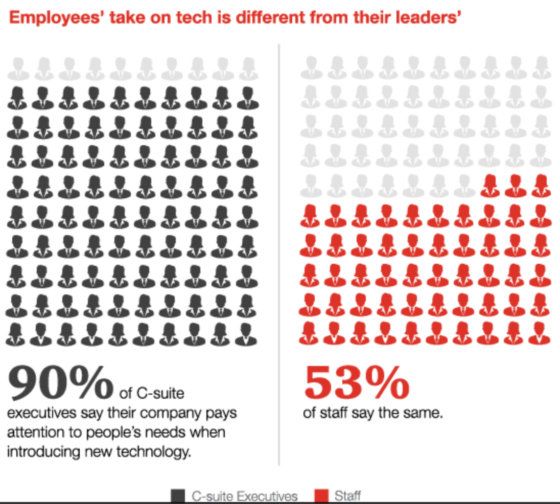Need a new ATS? No one cares, unless you speak their language
Learn from product marketing strategies to address specific buyer types in your organization, making a compelling case for a new ATS that aligns with business goals.

Imagine this: You’ve just come out of a big meeting where you’ve learned that your company plans to expand staff by 50% by the end of Q4. Normally, this would be an exciting step and a huge opportunity for you to really show your game.
But guess what? Your ATS (applicant tracking system) sucks. As you walk back to your desk (admittedly thankful that this long-winded meeting is finally over), you realize the nightmare that lies ahead: the crappy UIs, the broken buttons, the numerous clicks you have to endure to hire just one person – all that is about to be multiplied by 50.
And the person who has the decision-making power to bring in a new ATS just can’t be bothered, for whatever reason. The guys in IT are blocking it. Finance is slammed at the end of the quarter – that’s enough for you to not even knock on their door.
You know you’ll have to do more than give another lunchtime rant to your boss about the clunky ATS to make a switch happen. You open a new blank document to make your case. But the blank screen is as intimidating as those stern faces in Finance.
Contents
So where do you start?
To understand how to make an effective case for new software, it’s good to learn a bit from Product Marketing. That’s right, Product Marketing. This will help you understand why your boss doesn’t and, to an extent, shouldn’t give a shit that you don’t like your ATS’s clunky UI.
You’re probably familiar with the idea of “speaking someone’s language” when trying to persuade them to come around to your way of thinking. But knowing the underlying theory of why that’s important means you can make a more powerful case.
It will also help you personalize any “Convince Your Boss!” marketing collateral you’ve received from ATS vendors you’ve spoken to.
Another way to think about this is to think like a technology vendor. Vendors spend a lot of time thinking about how to sell, position, and talk about their product. This is the responsibility of Product Marketing, and it’s those folks we’ll learn a bit from now.
One of the key roles of Product Marketing is understanding a few simple ideas:
- Who are the buyers of the product?
- Why do the buyers start looking for the product?
- What process do buyers go through when evaluating and selecting a new software like this?
- What is important to the buyers?
- How do we position our product to appeal to those buyers?
In some cases, only one person (“buyer”) is involved in a buying decision, but usually there are more. By and large, in Product Marketing, these buyers are categorized into three groups according to the Pragmatic Marketing Framework. Each of these groups have different priorities:
Economic Buyers
- Hold the budget, sign the check
- Care about costs and ROI
- Request reports from the team to present to management
- Not necessarily users of the product
Functional Buyers
- Users of the product
- Care about features and ease of use
- Create reports for the boss
Technical buyers
- Care a lot about security, compliance, contracts, terms and conditions, access controls, technical details, nitty-gritty of integrations with other business tools in use, etc.
- Not necessarily users of the product
- Often includes legal, IT, operations, finance departments
Know who your players are
Knowing which “buyer bucket” the interested players in your company fall into is essential to the success of your business case for a new ATS. Let’s take a fictional company, Albion Inc. – relatively large, and in the exact same situation as you are: getting ready for hypergrowth for the upcoming year. Let’s meet some of their staff:
Jenny
Jenny is the HR Generalist who, as part of her role, looks after recruitment. If you were at Albion, you’d probably be Jenny.
Beth
Beth, the VP of Human Resources, is Jenny’s boss. She is responsible for all aspects of HR including budget management and planning.
Alex
Alex is the Sales Director. Albion is doing well and his team is growing fast, so he’s always hiring. In this case, he’s the hiring manager.
Georgina
Georgina is the Director of Operations. She doesn’t have any responsibility for hiring, but she is responsible for the maintenance, seamless integration, and security of Albion’s internal IT and tools — in other words, Albion’s tech stack.
Know their pain points and motivations
Now, let’s look at how each of them factors into the overall decision to purchase a new applicant tracking system:
Jenny
Jenny’s the one who just got out of the aforementioned “We’re growing by 50% this year” meeting. She is, to say the least, unhappy with the ATS Albion is currently using. It’s clunky, outdated and hard to use, and it’s slowing her down. She feels like she is spending more time on admin than on recruiting.
Jenny still has to do big chunks of recruiting herself that she is sure software could be handling, such as interview scheduling or advertising on job boards.
The headache doesn’t end there: she’s also feeling overwhelmed because she cannot stay organized and spends too much time chasing hiring managers, like Alex, for feedback on candidates. She’s simply given up on trying to get them to use their ATS at all.
Beth
Jenny has brought this up several times with her boss and decision maker, Beth, without much success. Beth, whilst understanding of Jenny’s frustrations, doesn’t see – yet – how a change to the ATS can be feasible.
To some extent, Jenny is the victim of her own success. She’s made the bad software work OK up to now by using workarounds and a lot of extra sweat and tears.
But Jenny knows this current setup will no longer work with the big growth plans. She’s at the end of her tether, and, just as she should be getting excited about the growth of the company, she’s looking down the barrel of a frustrating and stressful year.
Alex
Meanwhile, around the corner, Alex isn’t happy either. He needs to hire fast and he doesn’t feel like he knows what’s happening. Where are his resumes to review? What happened to that great candidate they spoke about last week? Did Jenny even follow up with the ones that Alex referred her to?
He loves Jenny as a colleague and as a friend, but he’s always been a little tripped up by her ad-hoc approaches to the hiring process with all the workarounds and little fixes. It was fine when hiring just a couple people here and there, but 50 new people, nearly all at once? How is all that going to work?
Lining up his own interviews, the countless trips to and from Jenny’s office at the other end of the building, not to mention trying to hire people remotely? Never mind the fact he’s just been told to boost sales by 50% by EOY – he’ll have to work harder than ever to make that happen.
Georgina
And Georgina over in IT has been working hard to build a seamless integration of all the different technologies used in Albion. The current ATS was a real beast to install and implement. Educating countless people on how to use it (and how not to) took up a lot of her time.
The learning curve felt insurmountable, even for a seasoned tech veteran such as herself. Now that it’s finally in place, she’s happy and she doesn’t want to rock that boat again.
Know what type of buyer they are
Now that you know what drives the players at Albion – and what drives them crazy – let’s categorize them by type of buyer:
Economic Buyer:
Beth is Albion’s economic buyer. She holds the budget and signs the checks for software purchases in HR. She gives final approval to all this stuff. Without her say-so, no decision can be made.
Functional Buyer:
We have two functional buyers at Albion who actually use the ATS. Jenny is the main user, and Alex uses it extensively as his department’s hiring manager.
Technical Buyer:
Georgina is Albion’s technical buyer. She’s simply interested in making the software fit comfortably within the existing system, and ensuring it’s compliant with security standards. More on Georgina later.
All of those players are part of the decision to start looking for a new ATS and which ATS to select. You need to get all of them on board, and you need to know how to convince them.
For instance, as an Economic Buyer, Beth isn’t going to be convinced by Jenny’s “it’s clunky and hard to use” argument. It’s not that Beth doesn’t care — she’s probably been in Jenny’s shoes in the past — but Jenny needs to make an actual business case for a new ATS in a way that is more aligned to Beth’s professional goals and motivations, and ultimately, Albion’s.
Know how to convince them to try a new ATS
By knowing the players in each category, Jenny now knows who she must convince. To do that, Jenny needs to know their drivers, what is going to convince them to make a switch. What is it that drives Beth, Georgina and Alex?
Convince the economic buyer
So what are the drivers of Economic Buyers when it comes to recruiting software? Well, each company is different, but it mostly boils down to two factors: budget and timeline.
Staying within budget:
- Do we have the budget for this?
- Will the new tool be more expensive?
- Will it save me money elsewhere in my budget, e.g. salaries, turnover, agency spend or advertising spend?
Staying on schedule:
- Do we have the time for this?
- Will implementation/learning of the new ATS delay the hiring plan?
- Will the new ATS optimize and speed up the hiring process, meeting goals ahead of time?
Whether you’re simply starting a conversation about getting a new ATS, actively deciding which one to buy, or making a case for the ATS you’ve decided is the best one for the business, you want to be ready to address each of the above questions and any similar concerns on the Economic Buyer’s mind. You want Beth to sign the dotted line and be able to sleep that night. You want her to know that targets will more likely be met with the purchase of this new ATS.
Instead of anecdotal arguments, here are some of the impacts we hear about Workable from the mouths of “Economic Buyers” who were involved in selecting Workable:
- “We’ve reduced our agency spend by 50%”
- “We’ve increased employee referrals by 33%”
- “We’re getting better quality applicants than before using Workable.”
See, no mention of ease of use. Economic buyers care about it, but it’s not the main driver in their decision making; just part of it. They simply have to balance this with other priorities that have been placed on them.
It is these reasons you need to take to your ‘Beth’ to help her understand the benefit of bringing in a new ATS in her “language”. Align your case to her goals and the strategic goals of the company. For instance, why is the existing ATS going to make it impossible to hit that 50% growth hiring plan, and why would a new tool make that possible?
Convince the functional buyer
Clearly, there’s not much convincing needed here. Jenny is the one pushing the case for a new improved ATS. You’re likely Jenny (or Alex) in this case, and you’re here because you want to press your case. So, let’s consider this part completed.
Convince the technical buyer
I mentioned earlier that we’d learn more about Georgina. And this is Georgina’s time to shine. Georgina is powerful. She can veto any software decision Jenny, Beth and Alex make – in fact, she can veto any software purchasing decision at Albion. She’s not the enemy – rather, it’s her job to make sure all the business’s tools work together nicely, are compliant and secure. If she’s not sure a new tool is secure or compliant, you’re back to the drawing board.
Georgina may not be involved in the decision to purchase a new tool, but once that decision has been made, you’ll want to make sure you know her requirements early on so you don’t get a nasty surprise just before signing a new contract. So, stop by her office to talk to her about what boxes she thinks the new software should tick.
Know that everyone cares – just about different things
Now that you have everyone on board – you, your Beth, your Alex, and your Georgina – you can write up that business case or an RFP (which will help you gather information about different recruiting solutions) and move forward in your plan to optimize the hiring process. Circle back to the start: you’re in that big meeting or in a follow-up meeting putting a concrete plan into place, and all heads turn to you when it’s time to talk about the hiring plan. You smile, because you have everyone on board for your new ATS, and you’re ready to show your game.
Shameless plug: Yes, Workable can help you meet those goals. Sign up for our demo and learn about what we can do for you. To learn all the things you need to know about an applicant tracking system and were afraid to ask, read this.
If you still have cold feet in regards to picking the right ATS for your business, this list of best applicant tracking systems in the market can help you make the right decision.
Frequently asked questions
- What challenges do inefficient ATS systems pose during rapid staff expansion?
- Inefficient ATS systems lead to increased administrative burden, poor organization, and hindered communication, complicating recruitment during rapid staff expansion.
- Why is understanding buyer types crucial in advocating for a new ATS?
- Recognizing buyer types (Economic, Functional, Technical) helps tailor your proposal to address their specific concerns, making your case for a new ATS more compelling.
- What factors do Economic Buyers consider when evaluating new software?
- Economic Buyers focus on budget compliance, ROI, and whether the new software aligns with strategic goals, like optimizing the hiring process.
- How can understanding the pain points of Functional Buyers aid in your proposal?
- Addressing Functional Buyers' needs, like user-friendliness and efficiency, demonstrates how a new ATS can streamline their workflow and improve recruitment outcomes.
- What role do Technical Buyers play in the ATS selection process?
- Technical Buyers assess software compatibility, security, and compliance, ensuring the new ATS integrates smoothly with existing systems and meets company standards.





